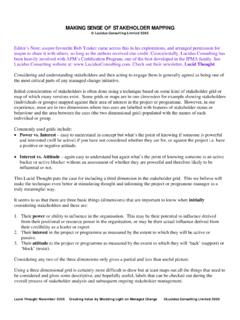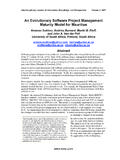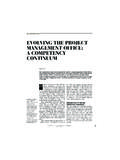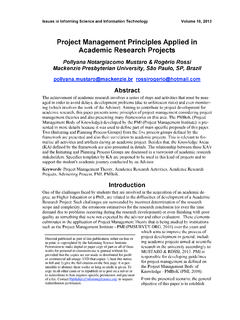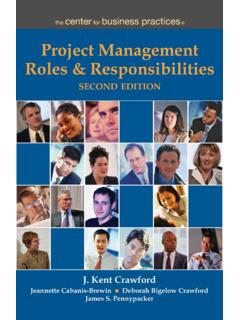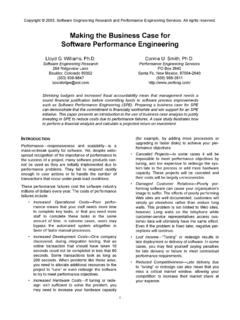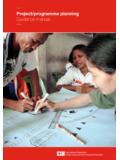Transcription of Defining The Hierarchy Of Project Objectives - IPMA-USA
1 2001 American Society for the Advancement of Project management , and Robert Youker Defining The Hierarchy Of Project Objectives Linking Strategy and Projects: originally presented at an IPMA Conference in Slovenia, 1998 Robert Youker (retired), The World Bank , and Jerry Brown; revised 2001 Abstract Clear and concise Objectives early in the life cycle are critical to Project success because they help ensure that Project stakeholders will develop a: Common understanding of what the Project is attempting to do, and Commitment to the same Objectives . When this does not happen, the result is confu-sion and conflict as stakeholders gradually dis-cover differences in their interpretations of the Project s Objectives .
2 It is important to get early agreement from all stakeholders that the Project Objectives are the ones that they want and that the enterprise needs. A tool for achieving this is the Hierarchy of Project Objectives , which we describe in the following topics: Introduction Levels of Objectives Why-How Framework Strategic Alternatives Horizontal Logic Summary Conclusions References Introduction The methodology was developed as a means of clarifying Project Objectives , both for planning purposes and for post- Project evaluation. The Hierarchy of Objectives serves a number of pur-poses; namely it can be used to: 1. Clarify the need or demand for the Project .
3 2. Clarify the requirements for meeting the need. 3. Communicate the Project Objectives to eve-ryone involved in the Project . 4. Promote appropriate Project design by en-couraging feedback from the people who are involved in, or affected by, the Project . 5. Enable the post- Project evaluators to meas-ure the Project s success in attaining its objec-tives. The Hierarchy provides guidance to the evaluators and helps direct their inquiry. 6. Demonstrate that the Project has different levels of Objectives , and clarify how the ob-jectives relate to one another in the Hierarchy . 7. Visibly link a Project to the enterprise s busi-ness strategy. Studies that focus on Project success and failure support what many experts believe.
4 Namely that the most important issue in Project man-agement is for the Project manager to get Project staff, beneficiaries, and other stakeholders to develop a common understanding, agreement, and commitment to a Project s Objectives . A shared perception about Objectives , agreement that the Project is worth doing, and the com-mitment to make it happen does not happen automatically. It takes effort and involves a con-siderable amount of communication. Levels of Objectives The Hierarchy of Objectives is a tool that helps analyze and communicate a Project s Objectives . The Hierarchy of Objectives organizes the objec-tives of a Project into different levels of a hierar-chy or tree.
5 Different organizations use different names for the various levels and the types of ob-jectives at each level. Otherwise, there is a great deal of similarity in approach. Our approach organizes Objectives into three broad levels: policy, strategic, and operational. In general, these levels correspond to the top, mid-dle, and working levels of management in an organization. Continued Defining the Hierarchy of Project Objectives /Youker, page 2 2001 American Society for the Advancement of Project management , and Robert Youker Levels of Objectives , continued Broad, general Objectives (some people call them goals) that policymakers deal with, such as im-prove economic growth, fall into the top level and are called policy Objectives .
6 Objectives that are narrower in scope, such as increase literacy for teenage girls, fall into the mid-dle level and are called strategic Objectives . Objec-tives that relate directly to a Project s deliverables fall into the operational level and are called Project Objectives . Objectives that relate to Project inputs what is needed to make a pro-ject function are also considered operational and are called input Objectives . Operational objec-tives are usually the concern of working man-agement, including Project managers. Figure 1 Figure 1 shows an example of a Hierarchy of ob-jectives for an electric power plant. The hierar-chy has four types of Objectives : policy, strategic, Project , and input.
7 They are grouped into three levels: policy, strategic, and operational. Policy Objective. The overall policy objective is to increase industrial production. We then ask: How is this to be accomplished? That brings us to the next lower objective, the strategic objective. Strategic Objective: One way the country is trying to increase industrial production, the policy ob-jective, is by producing 50 KW of electric power. This is the strategic objective for the Project . Presumably there are other strategic Objectives and additional projects that support the overall policy objective. Again we ask: How is the 50 KW of electric power to be obtained? The answer takes us to the next lower level of objective in the Hierarchy : the Project objective.
8 Project Objective: The Project objective in most cases is the same as the deliverable for the pro-ject. In this case, it is to build a new power plant. Asking: How is the power plant to be built? again takes us to the next lower level of objec-tive, the input objective. Input Objective: The input Objectives relate pri-marily to the resources and conditions that are required to accomplish the Project . For the power Project , they consist of a $10 million con-tract, land for the power plant, and necessary labor and expertise. You may have noticed as we went down the hi-erarchy of Objectives that each time we asked how a particular objective was to be accom-plished, we went to the next lower level objec-tive for our answer.
9 Why How Framework For example, if we ask: How is the 50 KW of power to be produced? The answer is at the next lower level and is the Project objective: Build a new power plant. This illustrates an interesting and useful aspect of the Hierarchy of Objectives . Each level answers the how question for the level that is immediately above it in the Hierarchy . But the Hierarchy also has another interesting char-acteristic that we haven t mentioned yet, al-though you may have noticed it. This relates to what happens when you go up the Hierarchy . For example, Why build the power plant? (the Project objective.) Answer: To produce 50 KW of power (the strategic objective.)
10 Continued Policy Objective Strategic Objective Project Objective Input Objective Increase Industrial Production Produce 50 KW Power New Power Plant $10 Million Contract, Land, Labor Defining the Hierarchy of Project Objectives /Youker, page 3 2001 American Society for the Advancement of Project management , and Robert Youker Why How Framework, continued This feature of the Hierarchy of Objectives is called the Why-How framework. The Why-How Framework is based on the Means-End Chain developed by March and Simon in 1958. When you ask why something is to be done you are asking about ends what is the purpose or objec-tive of the activity. When you ask how some-thing is to be done, you are asking about the means the strategy that will be used.

